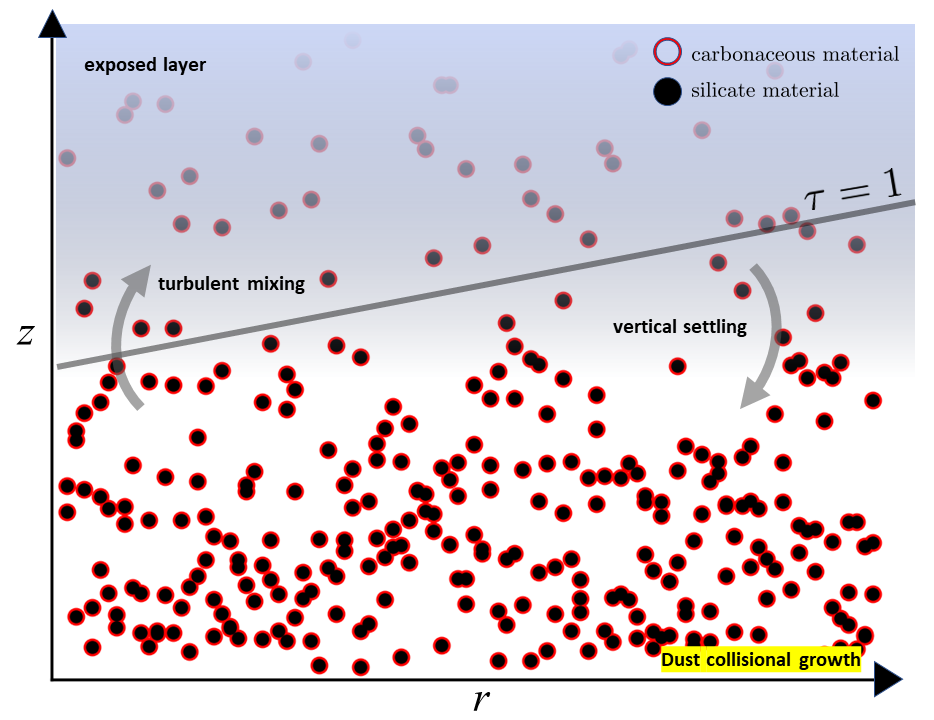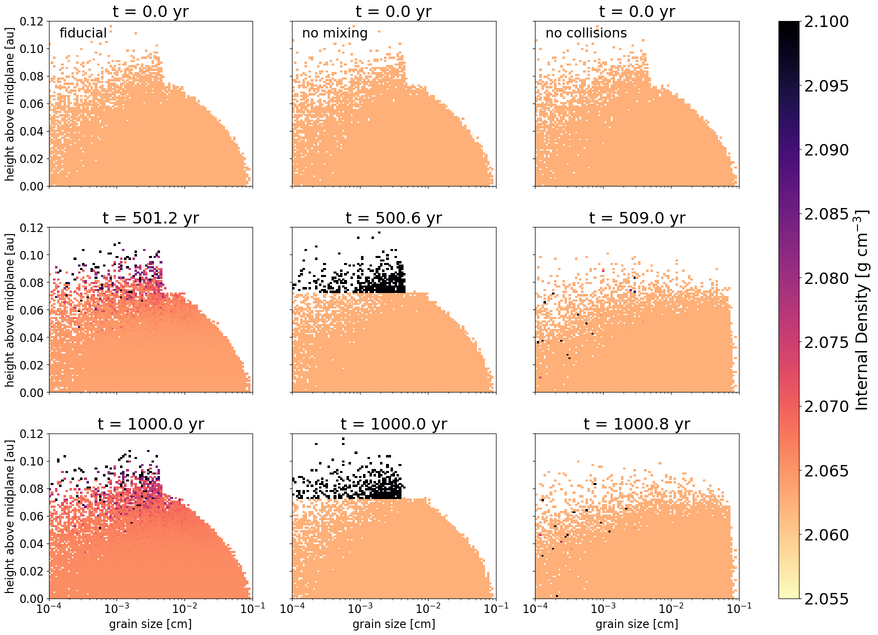Altered Carbon : Destruction of carbon in protoplanetary disks using Monte Carlo simulations
- 1University Observatory Munich, University of Munich (LMU), Department of Physics, Germany
- 2European Southern Observatory, Karl-Schwarzschild-Str. 2,85748 Garching, Germany
Introduction
The inner solar system is significantly depleted in carbon when compared to the interstellar medium, Observations suggest that the meteorites that formed early in the inner solar system are severely carbon deficit ([1]). The reason for the deficit is surprisingly unknown. Delving into why planet forming dust lose their carbon would give us important insights into the puzzle of planet formation. There have been efforts previously to address this puzzle but do not properly consider dust collisional growth ([2], [3]). We use a Monte Carlo dust evolution code that implements the physics of vertical settling, turbulent mixing and dust coagulation to explore how efficiently high energy stellar radiation can deplete carbon when dust collisional growth is considered.
Methods
We use a Monte Carlo code for dust coagulation that uses a representative particle approach ([4]). We introduce bouncing as one of the collisional outcomes and compare the distributions arrived with and without bouncing. We then track the carbon fraction of the representative particles. Vertical settling and mixing are the major driving mechanisms for the vertical dust grain movement. As these particles get exposed to the Far ultra violet (FUV) photons, they undergo photolysis. Fig. 1 shows the vertical profile of the model and the processes the dust grains undergo.

Fig 1: The vertical profile of the 1D model we use for investigation of photolysis in protoplanetary disks
Modelling photolysis requires an accurate description of the regions in the disk surface exposed to far-ultraviolet radiation (FUV). We find that the forward scattering nature of the dust grains and resonant scattering effects help the high energy (FUV) photons penetrate deeper into the disk. We devise a simple analytical model that takes into account the scattering of FUV photons and Ly-α photons ([5]).We make use of scattering phase function to find the probabilities of being scattered forward and downward, as these are the important directions that propagate FUV flux through the disk. We benchmark our analytical FUV model with a simulation from the sophisticated astrochemical code DALI ([6]). We find that our model is very much in agreement with the results of the code at lower optical depths, τ < =1. This is where most of the FUV flux resides thereby leading to a major chunk of carbon being lost in this region.
Results
Our results allow better modelling of carbon depletion in protoplanetary disks and stress the importance of collisional redistribution of species that acts as a way to replenish carbon to the exposed layers. This can be seen in the no collisions case in Fig 2.

Fig 2: The time evolution of three runs, (left) a simulation with collisions and mixing, (centre) without mixing and (right) without collisions. The simulations without collisions stresses the importance of collisions as a way to transport and replenish carbon to accelerate carbon depletion.
We present carbon destruction rates and the timescale of carbon depletion in the simulation at 1 AU and compare it with the present calculations. We arrive at depletion timescales ranging from 140-300 Kyr for different α parameter values as seen in Fig 3. When bouncing is included, the depletion is slower than in a no bouncing case. With our results, although we arrive at faster timescales than previous literature, it is not as fast as to deplete carbon before radial mixing of the outer disk species takes place. But recent evidence suggests that in the early solar system, the planet formation histories of the inner and outer disks are bifurcated due to weak radial mixing ([7]). Further work is needed to look into this aspect of radial mixing. We conclude that, although the photolysis alone is not likely to be the solution to the carbon deficit in the inner solar system, it is still an important process to take into account when developing quantitative predictions for the elemental composition of rocky exoplanets.
Fig 3. Carbon depletion time scale vs the α parameter for both the Analytical model and the DALI model.
References
[6] Bruderer S., 2013, Astronomy and Astrophysics, 559, 46
[7] Lichtenberg T., Drazkowska J., Schönbächler M., Golabek G. J., Hands T. O., 2021, Science, 371, 365
How to cite: Vaikundaraman, V., Drążkowska, J., Binkert, F., Birnstiel, T., and Miotello, A.: Altered Carbon : Destruction of carbon in protoplanetary disks using Monte Carlo simulations, Europlanet Science Congress 2022, Granada, Spain, 18–23 Sep 2022, EPSC2022-647, https://doi.org/10.5194/epsc2022-647, 2022.

